Tech meets F&B: This Korean fried chicken joint uses robots to automate frying, now in S’pore

The preparation of fried chicken can be a laborious one, especially when it comes to Korean fried chicken, which is typically double-fried.
Even if you manage to nail the process perfectly, achieving that perfect golden crispiness is a challenge — too much oil can make it soggy, while a low oil temperature can prevent it from achieving that satisfying crunch.
This is where tech innovation steps in. Robert Chicken, a Korean fried chicken joint in Singapore, takes the art of creating the perfect Korean fried chicken to a whole new level — with robots.
At the helm of this culinary revolution is Robo Arete, a South Korean robotics startup founded by the visionary 38-year-old Jiyoung Kang.
How do the robots work?
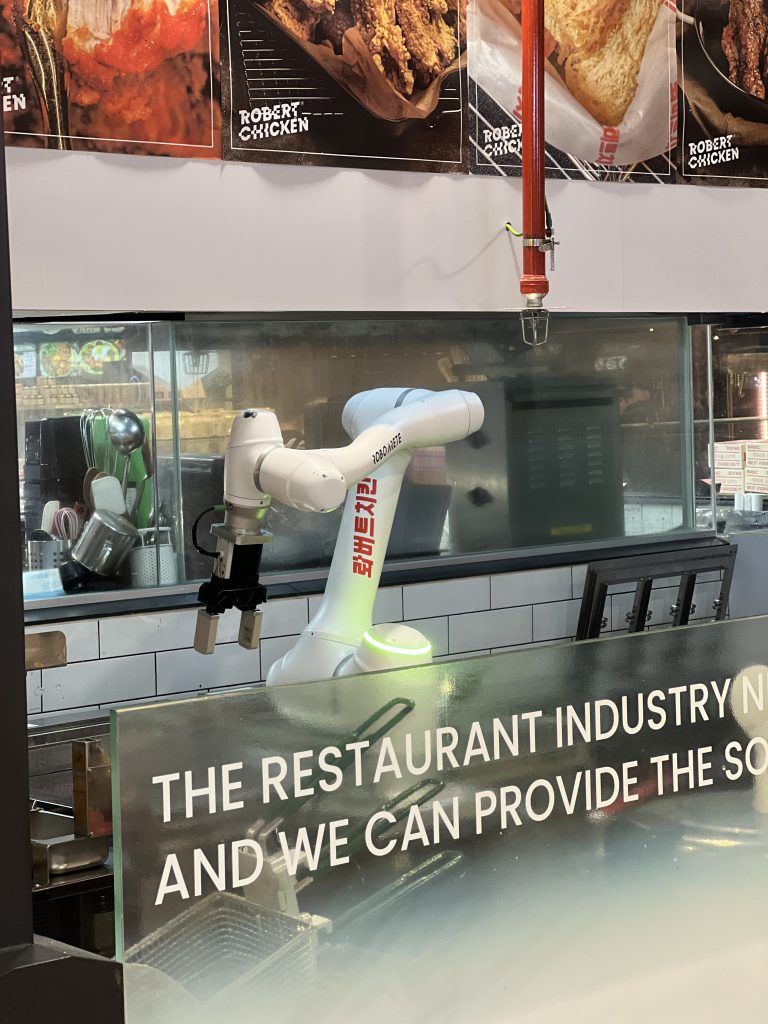
While Robert Chicken utilises robots to solely automate frying processes in Singapore, the restaurant chain employs them to handle various tasks such as breading, battering, marinating, and frying, across its outlets in South Korea.
To begin the process, a staff member has to firstly place the raw chicken into a bucket. With the touch of a few buttons, the bucket automatically rotates, and a robot dispenses breadcrumbs onto the chicken and stirs it to ensure an even coating.
Following this, the robot will transfer the breaded chicken into a frying machine. Another robot will then take over the frying process, tossing the chicken from time to time to ensure that it is evenly cooked.
Once the chicken is perfectly done and crispy, the robot removes it from the oil, giving it a few good shakes to remove as much oil as possible, before a staff member coats the chicken in sauces.
The operation system of these robots, which is certified by the United States’ National Sanitation foundation, is also cloud-based. This allows Robo Arete to monitor the status of system in real-time and respond to any issues directly.
Robert Chicken’s founder was a former venture capitalist
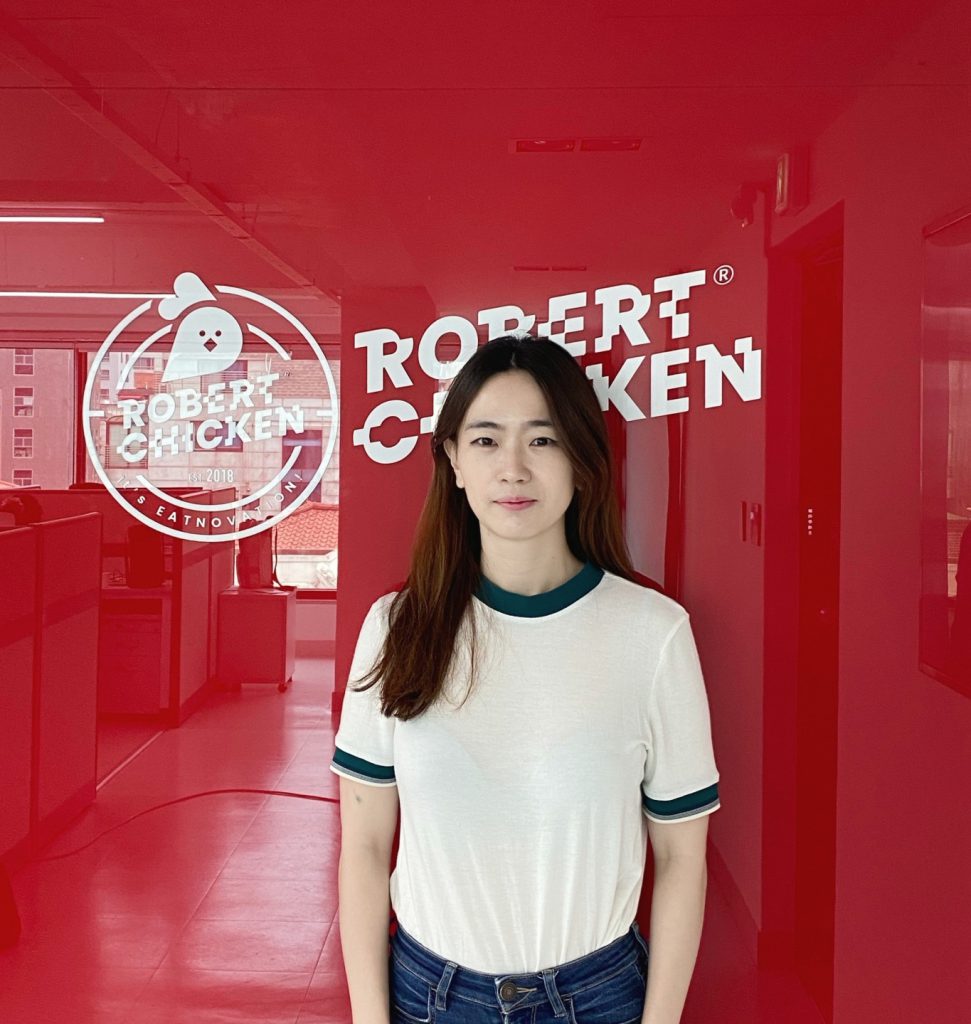
Prior to starting up Robo Arete, Jiyoung was a partner at a South Korean venture capitalist firm, Fast Ventures, where she identifies and analyses market trends in the startup scene on a daily basis.
While analysing these market trends, South Korea’s food delivery industry, in particular, caught Jiyoung’s attention. In 2018, the industry boasted a valuation of around ₩5 trillion (about S$5 billion) — capturing even a modest one per cent market share would yield substantial gains.
However, the food delivery market is notoriously hard to penetrate, given that the industry is saturated with renowned players that have a huge brand presence across the country.
The only way for a company to stand out in this competitive market is by carving out a niche, such as automation. This not only sets the company apart, but also allows for the consistent delivery of high-quality food with unparalleled taste.
Why isn’t the cooking robot market bigger yet? There were no companies attempting [automated cooking] in Korea back in 2018. If that’s the case, I should do it myself, but what kind of food automation would make sense in [South Korea]?
With these thoughts in mind, I naturally started thinking about the Korean food delivery powerhouse: chicken.
– Jiyoung Kang, founder and CEO, Robo Arete

Jiyoung turned her idea into reality with the inception of Robo Arete — the parent company of Robert Chicken — in 2018. Fast forward to today, there are 11 Robert Chicken outlets spread across South Korea, with an additional outlet in Singapore. The Singapore location, which opened in June 2023, marks the brand’s first international expansion.
When asked about her decision to launch in Singapore, Jiyoung explained that she sees similar potential for disruption in the city-state’s F&B scene.
“The use of technology, such as food delivery apps and contactless payments, is already prevalent in Singapore’s F&B sector. There is an opportunity for further technological disruption, including automation in kitchens,” she added.
The company faced a turning point in 2019
Despite Robert Chicken’s successful international and local expansion, Jiyoung admitted that the brand faced multiple setbacks when it initially started out in the South Korean market back in 2018.
While her experience as a VC played a tremendous role in kickstarting the venture, she lacked the experience and specialised knowledge required to run the relevant technologies for Robert Chicken.
I initially had little knowledge of these technologies. Consequently, when I sought out experts, I often faced dismissive attitudes, and I endured numerous financial, physical, and emotional hardships. But when I reflect on it now, I believe that these challenges were what enabled me to ultimately “realise” my vision.
– Jiyoung Kang, founder and CEO, Robo Arete
In 2019, Robo Arete faced a turning point when it managed to secure funding from the South Korean government. With the funds, the company invested into acquiring its first robot and subsequently launched Robert Chicken’s first outlet in Gangnam district of Seoul, South Korea, four months later.
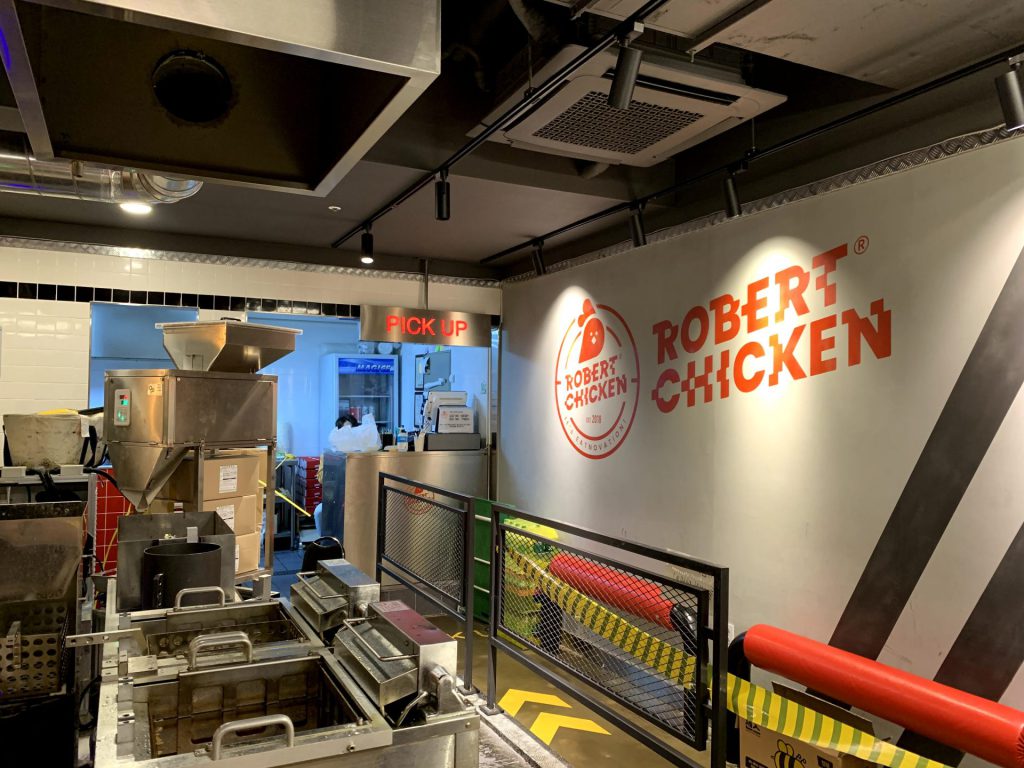
Since the launch of Robert Chicken’s first outlet, the company has consistently channeled its efforts into refining its robot models to boost the efficiency of its stores and lower operational costs. Initially, each of its robots could only operate one fryer at a time as they were attached to the floors of its stores.
For the opening of its second branch, the company attached “robot arms” to the ceiling of its stores instead, allowing each arm to overlook three fryers at once without compromising the quality of its offerings.
“I don’t think there’s any point in doing a food business with robots if it can’t boost productivity,” Jiyoung said in a separate interview with Korea JoongAng Daily. “I don’t want our robots to boast flashy performances. I want them to be fast, precise in their job, with zero fluctuations in food quality.”
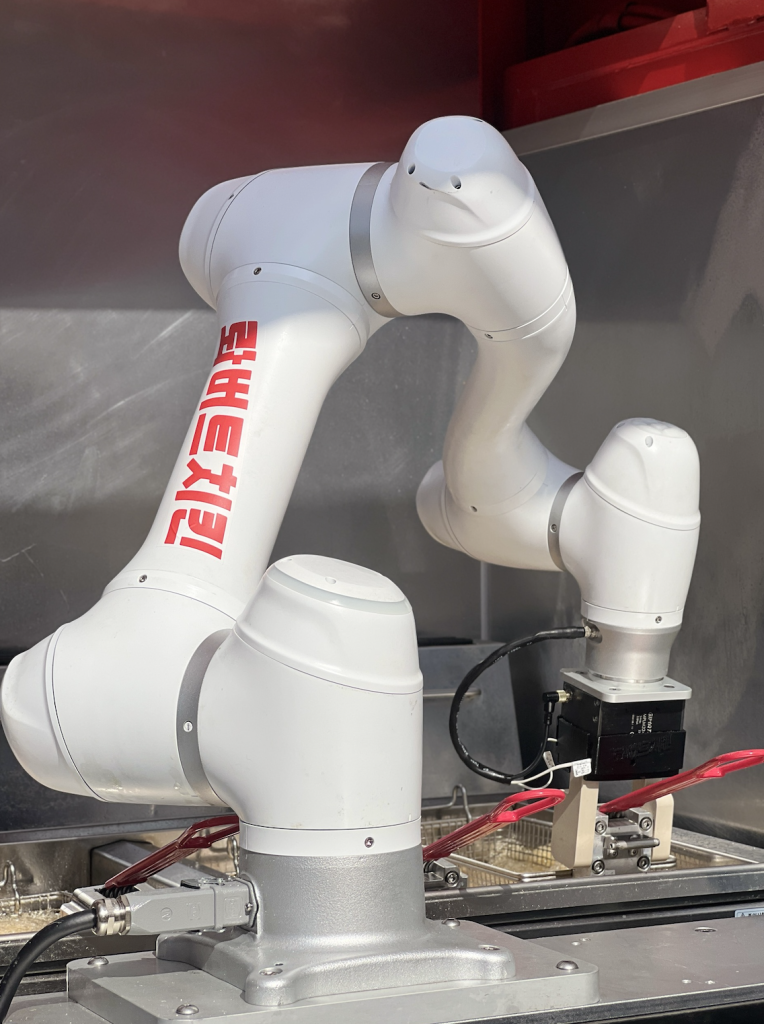
Jiyoung shares that Robo Arete’s robots can now “perfectly carry out the entire frying process of all kinds of items”. These robots can also be connected to delivery apps, allowing them to automatically start preparing orders once it receives data from users.
Beyond boosting the operational efficiency of its robots, Robo Arete has also carried out significant R&D to elevate the flavour profile of its fried chicken. After all, taste is what ultimately draws customers in.
When the startup carried out its first tasting session, Jiyoung was quick to admit that it was nothing short of “a disaster”. The company unveiled eight menu items, but only one of it — the plain fried chicken — garnered favourable comments.
Recognising the need for improvement, Robo Arete continued developing and refining the recipes of their sauces. To further bolster their efforts, the company forged a partnership with a renowned “sauce expert” — who has a track record with one of South Korea’s leading fried chicken franchises — to come up with new dishes and sauces that would perfectly complement these dishes.
Robert Chicken plans to expand to US next
As the company continues to grow, Jiyoung shares that it plans to expand and open more Robert Chicken stores, both across South Korea and internationally, through a master franchise business model.
In the coming months, it is looking to open a Robert Chicken flagship store in New York City, one that would be situated right next to the Empire state building.
Beyond Robo Arete’s expansion plans for its fried chicken brand, the company is adopting a business-to-business (B2B) model to supply its automated frying system to restaurants that may be struggling with labour issues.
To do this, the brand has developed a compact system of these robots, making them smaller and more cost-friendly to allow just about any business to “easily run their own automated kitchen without a large investment and space” to operate these robots.
Our ultimate goal is to make it easy for anyone to open an automated store, and to be able to serve customers personalised menus that can be automatically prepared according to personalised recipes.
– Jiyoung Kang, founder and CEO, Robert Chicken
Embark on your startup journey with MAS-regulated ANEXT Bank, one of Singapore’s first digital banks for SMEs.
Featured Image Credit: Robo Arete
Also Read: Anya Active founder champions body positivity with size-inclusive activewear after personal struggle
CelcomDigi celebrates 1-yr anniversary, offers new 5G plans & affordable phone packages
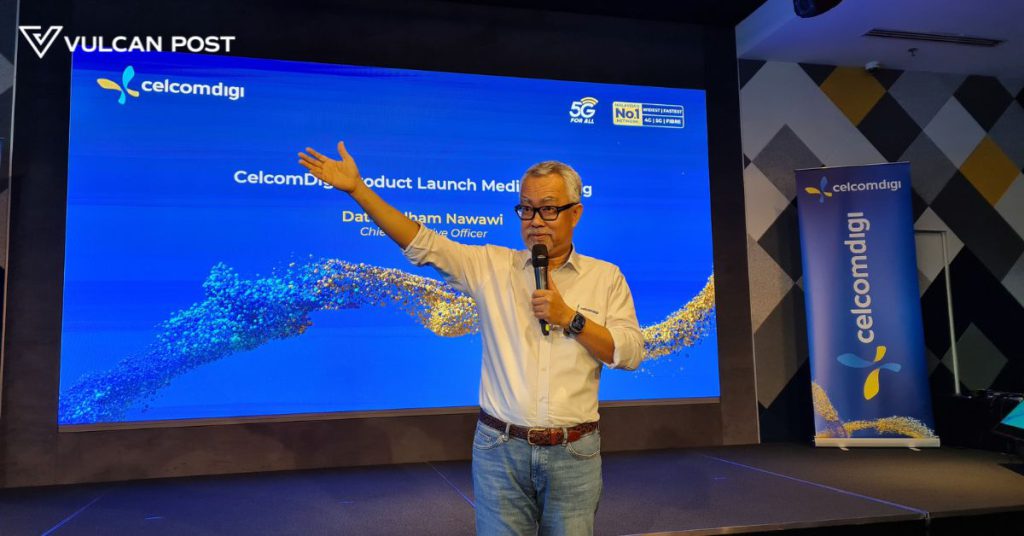
Last year on December 1, telecommunication giants Celcom and Digi came together under a momentous merger, becoming the portmanteau of CelcomDigi.
Celebrating its first-year anniversary, the company welcomed members of the media to the first media briefing held in its CelcomDigi Hub, located at Subang Hi-Tech Industrial Park.
Here, CEO Datuk Mohamad Idham Nawawi took to the stage to share some milestones and statistics the company has achieved since the merger a year ago.

For one, the company has been on track with its network integration progress to modernise its network in clusters, having successfully modernised 4,402 sites.
The CEO also referenced the company’s collaboration with various companies such as Yinson Holdings, DHL, and VIRNECT, just to name a few.
He shared that the company is making a lot of technological investments. Beyond that, he also said CelcomDigi is working on lifestyle innovations and services.
Continuing on its journey to provide 5G for all
CelcomDigi is offering its third product called CelcomDigi 5G Postpaid under the unified branding. The first two products being CelcomDigi Fibre and CelcomDigi Business.
To go live on December 1, CelcomDigi 5G Postpaid has six plans with varying prices, speed, and data, namely:
- Postpaid 5G 80
- Postpaid 5G 100
- Postpaid 5G 120
- Postpaid 5G 140
- Postpaid 5G 160
- Postpaid 5G 260
The full details of the new products are as shown in this graphic:

All plans are bundled with unlimited calls and six months of free home fibre at 300 Mbps. Those who have any contracts with CelcomDigi will get to enjoy a rebate of RM10 on their plans.
Those switching to CelcomDigi from other networks will also get a RM10 rebate for six months or a RM30 rebate for 24 months if signing up for the highest Postpaid 5G 260 plan.
The Postpaid 5G 260 plan also offers extra benefits such as 300 Mbps Ultra-fast Home Fibre, as well as 50% off family lines and Gadget SIM offerings.

The 5G-enabled family lines allow users to connect up to six family members at RM40/month per line. This plan includes unlimited calls, 90GB of 4G/5G data with a 100Mbps speed cap.

The higher-tier Family Plus plan at RM50/month per line provides unlimited internet at a higher 300Mpbs speed as well as 20GB extra hotspot data.
At RM30/month, a Gadget SIM comes with 30GB of data with an internet speed of up to 100Mbps. There’s also the GadgetSIM Plus plan at RM50/month, offering 300GB of data with a higher 300Mbps speed cap.

Equipping Malaysians with 5G phones
Aside from having the appropriate 5G plans in place, the fact is that you need an appropriate device to be able to utilise the technology.
CelcomDigi believes that only one out of five Malaysians have a 5G-enabled phone. This means that a big majority of Malaysians still cannot make use of 5G technology in the first place.
To help more Malaysians upgrade to a 5G phone, CelcomDigi is also introducing two phone programmes:
- Easy360: An instalment plan for up to 36 months with zero upfront payment and zero interest charges. It’s available for a range of phones including the latest models, such as iPhone 15, Samsung Z Fold and Flip 5, and Oppo Flip N3.
- Pakej MegaJimat: Free 5G phones such as the Samsung Galaxy M14 5G, ZTE Blade A73 5G, and Vivo Y27 5G when you sign up for their Postpaid 5G 80 plan under a 12-month contract.
From Malaysia to the world
CelcomDigi will also be launching its 5G Roaming Worldwide plans. These are data roaming passes allowing Postpaid 5G customers to get connectivity while abroad.
The most affordable package is the three-day RM25 plan with 2GB of 4G/5G internet, which is available in 23 countries. Extra 2GB of data will be added for this plan when purchased in neighbouring countries such as Singapore, Indonesia, and Thailand.

There’s also the seven-day plan at RM58 and 30-day plan at RM98, which will offer unlimited 4G/5G internet. The former is available in 20 countries, while the latter can be purchased in 57 countries.
Customers of CelcomDigi’s Postpaid 5G 120 plan and above will get 50% off these passes from December 1, 2023 until March 21, 2024.
More information on all the new products will go live on CelcomDigi’s website on December 1, 2023.
Also Read: 10 can’t-miss events from Startup Week, hosted by the largest entrepreneur FB group in M’sia
Fintech firm Aspire unveils new S’pore HQ – aims to double headcount to 300 by 2025
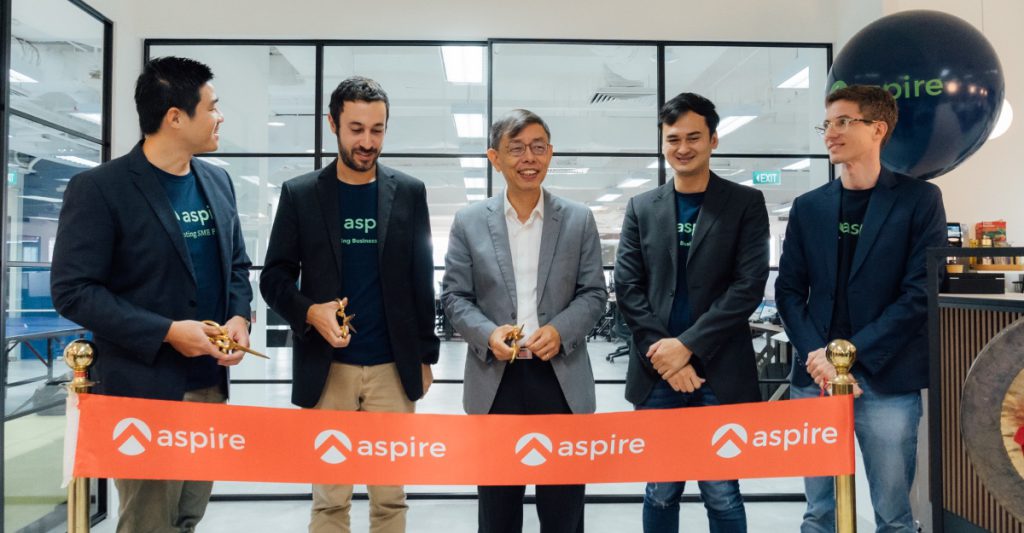
Aspire, an all-in-one finance platform for modern businesses, announced the official opening of its new headquarters (HQ) in Singapore yesterday (November 29), as the company doubles down on driving fintech R&D and innovation in the region.
The HQ will serve as the company’s financial technology excellence hub in Singapore, through which it will drive product R&D and invest in strategic technologies at the core of the fintech industry such as cybersecurity and artificial intelligence.
One such example is a whitepaper on the opportunity and practical implications of AI for finance teams — jointly published with PwC Singapore — which Aspire plans to embed learnings directly into its suite of products.
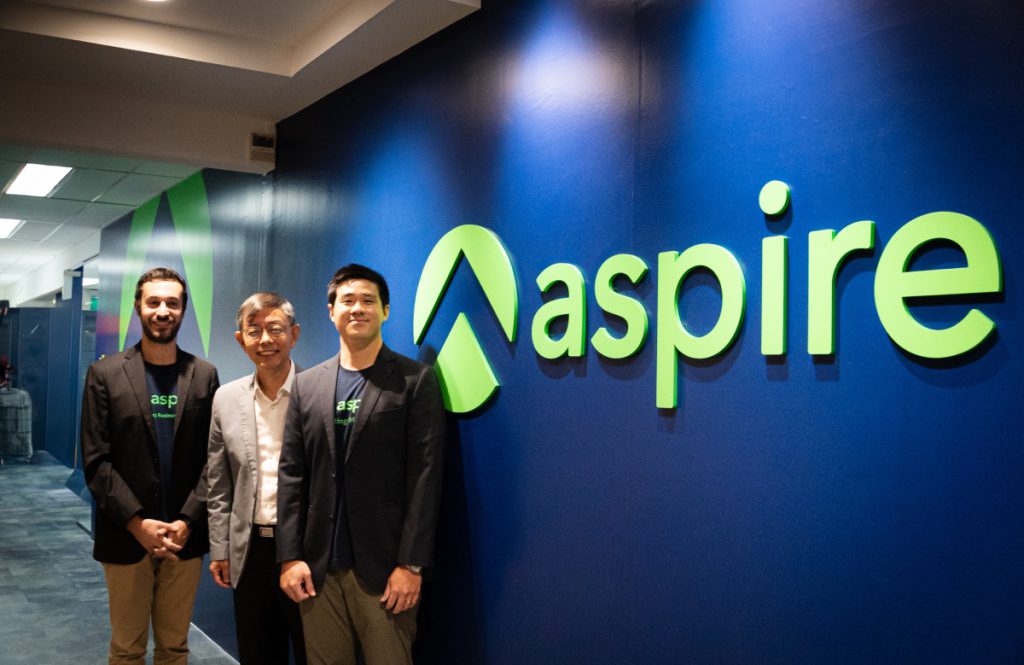
Alongside the launch, Aspire announced the company’s plans to double its local workforce of skilled fintech talent across various departments including engineering, product and data analytics in Singapore to 300 by 2025.
Singapore has been the epicentre of our regional operations, thanks to its international connectivity, skilled tech workforce, and robust government support for fintech innovation. We are fully committed to the local fintech ecosystem and plan to invest more to continue to tap on the nation’s strong infrastructure and foundations.
The next generation of Asian businesses needs an integrated, borderless, modern finance solution. At Aspire, we’re building the future of business finance for APAC’s digital economy.
– Andrea Baronchelli, CEO and co-Founder, Aspire.
Aspire has raised more than US$300 million
Earlier in February, Aspire closed an oversubscribed Series C funding round, raising US$100 million from a group of investors that include Lightspeed, Sequoia Capital SEA, Paypal Ventures, LGT Capital Partners, Picus Capital, and Mass Mutual Ventures.
Since its launch in 2018, the company has raised a total of more than US$300 million. Today, Aspire boasts a client base of over 15,000 businesses across Asia, and has successfully achieved profitability this year.
It was also recently recognised as one of the Top 100 most promising fintech startups globally.
Speaking at the opening event, Peter Ong, Chairman of Enterprise Singapore said, “I am heartened to see Aspire continue pushing the boundaries of fintech to drive the growth and transformation of more businesses.”
“Aspire’s plans to expand its team in Singapore is a positive step forward that will help to spark more innovation in our startup ecosystem. Enterprise Singapore is committed to working with our partners to deepen support for startups such as Aspire, and help them scale locally and abroad.”
Featured Image Credit: Aspire
Also Read: Rising against the odds: Here are S’pore’s top 10 startups, according to LinkedIn’s 2023 list
Between Oxford and Yale: NUS graduates ranked 9th most sought-after by global employers

For the fourth year in a row, the National University of Singapore (NUS) has kept its position within the Top 10 in Global Employability University Ranking and Survey conducted by a French HR consultancy Emerging and Times Higher Education.
Dropping in ranking from 8th in 2023 to 9th for 2024, NUS landed between two global heavyweights: University of Oxford and Yale. In Asia, it was outscored by only the University of Tokyo, in 7th place.
| UNIVERSITY | COUNTRY | RANK 2024 |
|---|---|---|
| California Institute of Technology | USA | 1 |
| Massachusetts Institute of Technology | USA | 2 |
| Stanford University | USA | 3 |
| University of Cambridge | UK | 4 |
| Harvard University | USA | 5 |
| Princeton University | USA | 6 |
| The University of Tokyo | Japan | 7 |
| University of Oxford | UK | 8 |
| National University of Singapore | Singapore | 9 |
| Yale University | USA | 10 |
| Imperial College London | UK | 11 |
| University of Toronto | Canada | 12 |
| Technical University of Munich | Germany | 13 |
| Peking University | China | 14 |
| ETH Zurich | Switzerland | 15 |
| Columbia University | USA | 16 |
| New York University | USA | 17 |
| IE University | Spain | 18 |
| CentraleSupélec – Paris Saclay University | France | 19 |
| University of California, Berkeley | USA | 20 |
We are pleased that NUS graduates are among the most sought-after by employers in Singapore and internationally. The transformative education at NUS, embodying academic rigour, experiential learning, global exposure and real-world relevance, has strongly equipped our graduates with robust employment prospects.
– Professor Aaron Thean, NUS Deputy President (Academic Affairs) and Provost
The survey itself appears to be very thorough, with schools assessed on 35 different categories across six employability drivers: academic excellence, specialisation, graduate skills, focus on work expertise, social impact and leadership, and internationality.
In this year’s edition, 100,700 votes have been collected, covering 11,560 employers across 21 countries, who are expected to collectively employ approximately 800,000 graduates globally in the 2023/24 period.
Responsible globalisation
NUS’ high position is a reflection of a broader trend seeing schools in emerging countries rising to the top.
10 years ago, the ranking was dominated by universities from US and UK, which took up 58 per cent of the spots. Today, it’s only 27.5 per cent — though they are still dominant at the very top, with 12 out of Top 20, or 60 per cent of the entries.
Skills most desired by employers are quite predictable, with high demand for graduates with team collaboration, social impact and leadership traits, as well as technical proficiency — with 40 per cent of the Top 50 spots taken this year by tech schools.
The research shows the key skills employers are increasingly looking for, and this year, it’s fascinating to see social impact and leadership as the key skill they’re looking for. It shows how employers want graduates who can make a significant contribution not only to their company, but also to the wider community and the country too.
– Seeta Bhardwa, Editor, THE Student
To that end, NUS keeps enhancing its service offering to students, having opened Singapore’s first honours college earlier this year, offering its third interdisciplinary programme in addition to Humanities & Sciences, and Design & Engineering, covering an entire spectrum of academic endeavours.
Also Read: MOM data: S’pore job market slows down – fewer companies hiring, only 18% plan to raise wages
The future of digital money: Singapore sets the standard for stablecoin adoption

Singapore doesn’t look too favourably upon cryptocurrencies, but it’s still paving the way for the adoption of digital assets.
When it comes to cross-border transfers and a more efficient banking system, the Monetary Authority of Singapore (MAS) is placing its faith in stablecoins, CBDCs, and tokenised bank liabilities rather than Bitcoin and Ethereum.
As MAS’ Managing Director Ravi Menon explained at the Singapore Fintech Festival 2023, cryptocurrencies have failed the test of digital money, but these other asset classes could prove suitable given the right infrastructure and regulations.
Earlier in August, the MAS announced a regulatory framework addressing the value stability of stablecoins. This issue has taken the spotlight a number of times over the years, ever since the emergence of coins such as USDC and USDT, which are meant to be pegged to the US dollar.
In 2021, Tether – the company behind USDT – was fined millions of dollars for false claims that its stablecoin was fully backed by fiat currencies. Tether misled consumers into believing that the amount of USDT issued was equivalent to the amount of US dollars which the company held. This would ensure liquidity and allow USDT to be swapped at a rate of US$1 at any given time.
In reality, the Commodity Futures Trading Commission (CFTC) found that Tether held sufficient reserves for less than 30 per cent of the days between 2016 and 2018. Since then, the integrity of stablecoins and the transparency surrounding their reserves has come under scrutiny.
Singapore’s solution for stablecoins
The MAS’ regulatory framework for stablecoins specifies a set of requirements, which issuers of stablecoins must meet. This includes criteria around the minimum reserves, which must be held and disclosures that must be provided to holders.
Issuers also have to ensure that their stablecoin can be exchanged for the underlying fiat currency within five days of a request being issued.
As it stands, StraitsX and Paxos have received in-principle approval to issue MAS-regulated stablecoins. For StraitsX, this includes XSGD, a Singapore dollar-backed stablecoin which was first issued in 2020. It also includes the US-dollar-backed XUSD stablecoin which is due to be launched in the near future.
Meanwhile, Paxos is set to issue a new US dollar-backed stablecoin as well, in partnership with enterprise clients in Singapore.

Regulation will absolutely play a key role in shaping the development of the stablecoin market. Countries such as Singapore and Japan have recognised that stablecoins can play a foundational role in the digital asset and broader Web3 ecosystem. Their policy frameworks are aimed at creating space for high-quality stablecoins to take root.
– Chengyi Ong, Head of APAC Policy, Chainalysis
With its regulations, the MAS could help provide stablecoins with the legitimacy needed for them to take on the role of digital money. Investors would have the reassurance that coins such as XSGD and XUSD are just as safe to hold as their fiat counterparts.
Growing demand for stablecoins
As the demand for crypto assets begins to rise yet again – with Bitcoin fund inflows surpassing US$1.5 billion this year – stablecoins are picking up right where they left off.
“Stablecoins are the backbone of the crypto economy. They are the most widely-used type of crypto asset,” explains Chengyi Ong, Chainalysis’ Head of APAC Policy.
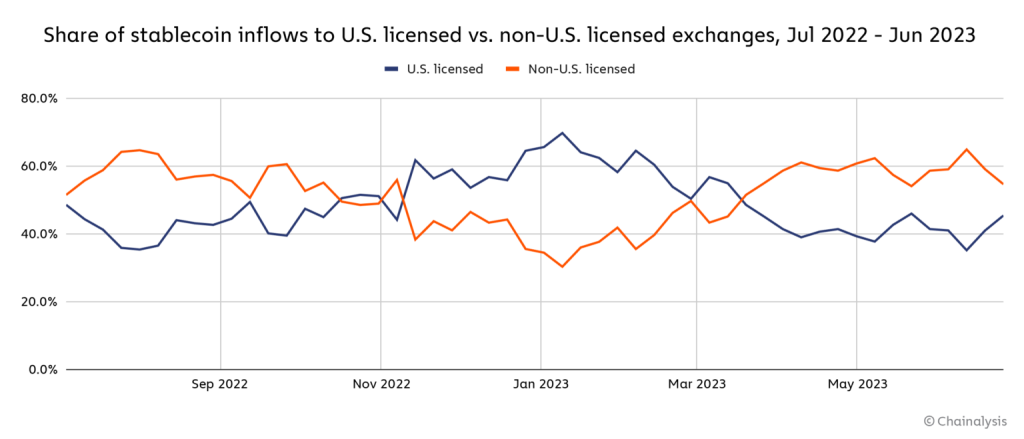
According to Chainalysis data, more than half of all on-chain transaction volume to or from centralised services between July 2022 and June 2023 took place in stablecoins. “Growth in stablecoins will support broader crypto activity, and vice versa.”
Stronger regulations will contribute to this growth, inviting institutional participation and facilitating the use of stablecoins in a wider variety of transactions.
“Transactions involving USD-backed stablecoins reached nearly US$6.87 trillion in 2022, surpassing the volumes of Mastercard and PayPal,” Ong says. “If institutional and retail adoption continues, we could continue to see stablecoins accounting for a larger share of on-chain value transfer.”
Stablecoins backed by commodities
Currently, MAS’ stablecoin regulations only address single-currency stablecoins (SCSes). These refer to stablecoins which have values pegged to a fiat currency such as the Singapore dollar or US dollar.
SCSes are the most commonly used stablecoins today, however, there are other forms which have emerged in recent years as well. This includes stablecoins pegged to precious metals such as gold and silver.
For example, each of Paxos’ PAXG tokens represent one fine troy ounce of gold stored securely in a vault in London. This offers a convenient way to invest in gold as there are no storage fees, the minimum purchase amount is extremely low, and transactions are settled almost instantly.
Commodity-backed stablecoins could help make traditional assets more accessible and ease the investing process.
“These tokens represent a much smaller market share today. Whether they grow in popularity will depend on the value they provide to end-users, as well as the regulatory frameworks that will be established around them,” Ong explains.
Featured Image Credit: Composite Ledger Insights, elements 123rf
Also Read: “Cryptocurrencies have failed the test of digital money”: MAS’ MD Ravi Menon on the future of fintech
Japanese luxury department store opens at The Exchange TRX, offers 700+ global brands

Yesterday (November 29), SEIBU, the luxury Japanese department store opened its first Malaysian outlet at The Exchange TRX in KL.
This is the third SEIBU store overseas, with the second one opened in Indonesia last year. It’s designed by UK architects HMKM and Cardy Papa, who are known for creating award-winning department store designs globally, including the Tryano in Abu Dhabi.

According to the press release, SEIBU KL’s design concept places a strong emphasis on luxury, combining elegance and vibrancy to create an atmosphere that “sparks a sense of joy and exploration”.
The new KL outlet occupies four levels and is 265,000 sq ft, where it houses over 700 luxury international brands. A feat that no other department stores in Malaysia has achieved, the press release stated.
Out of the 700, more than 100 of these brands are debuting in the Malaysian market exclusively at SEIBU KL. This includes names like Fred, Damiani, Niessing, and Pierre Hardy. Customers can also find over 100 Japanese brands to shop from.
Aside from that, beauty fans will be pleased to know that SEIBU KL houses the largest Beauty Hall in the nation, the release shared. Located on its ground floor, the hall houses 116 skincare, makeup, and cosmetics brands.
In addition, its Shoe Salon is reportedly home to the largest selection of luxury shoes and bags in a department store. Visitors can expect to find 20 premier international footwear brands, including Giuseppe Zanotti, Rupert Sanderson, and Sergio Rossi.

Similar to its other departments, SEIBU KL’s Food Hall also has local and global names to choose from for a variety of cuisines.
For example, patrons could visit the popular Kenny Hills Bakers, Mori Kohi, Wagyu Beef One-Six, Miyatake Udon, and Tarbushi Ramen. Among the restaurants debuting at SEIBU include Sushi Suzuki and La Marche.
From Japan, to Malaysia
The opening ceremony was officiated with a resounding and auspicious “Wadaiko”, a Japanese drum performance. Along with that was the breaking of the “Kagami-Biraki”, a sake ceremony symbolising a new and prosperous beginning for SEIBU KL.

In attendance were Takahashi Katsuhiko (Ambassador of Japan to Malaysia), Datuk Alfred Cheng (Chairman of SEIBU KL), Datuk Khadar Merican (Chairman of SOGO KL), Datuk Andrew Lim (Deputy Chairman of SOGO KL), Mitch Wilson (Project Director for The Exchange TRX and Head of Retail for Lendlease Malaysia), and Nobuharu Yutani (Managing Director of SEIBU KL).
Based on its press release, the collective investment in SEIBU KL is in excess of RM150 million, with the objective to create a top-tier shopping destination in Malaysia. Along with that, it reports that the store is set to provide employment opportunities for a thousand-strong workforce.
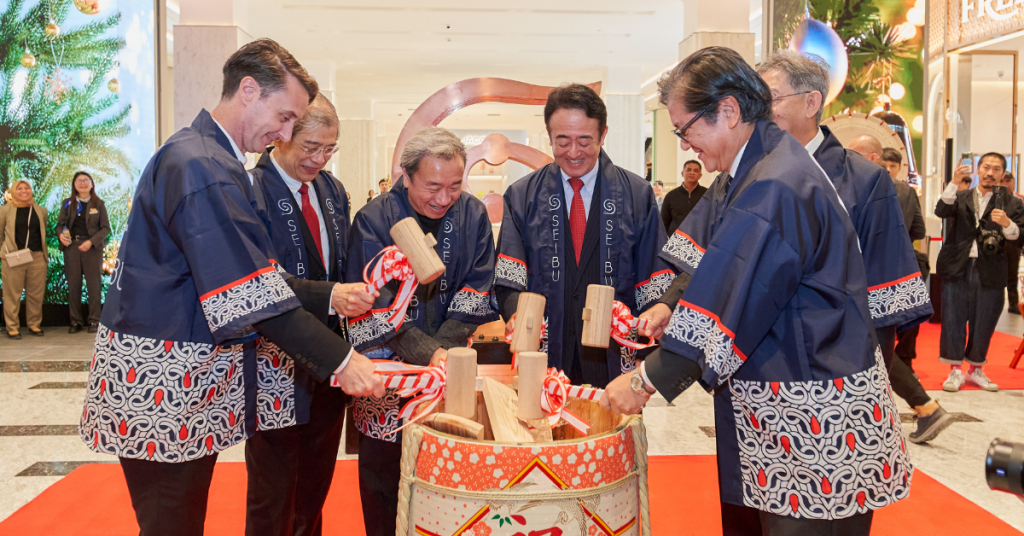
In addition to innovative and new merchandise, SEIBU is collaborating with Hiroko Takahashi to design a special collection for the department store. On top of that, she has designed Seibu’s staff uniforms, store packaging, gift items, and other contemporary elements.
For context, Hiroko is a renowned Japanese designer and artist, whose portfolio includes names like Apple, Fendi, and Adidas.
“At SEIBU, we are not just a department store but a place for you to shop, eat, drink, socialise, and even get some pampering! We aim to provide the best ‘omotenashi’ service in the Japanese way,” Yutani stated.
Dictionary time: “Omotenashi” is a Japanese expression that means to wholeheartedly look after guests.
Source: Travel Japan
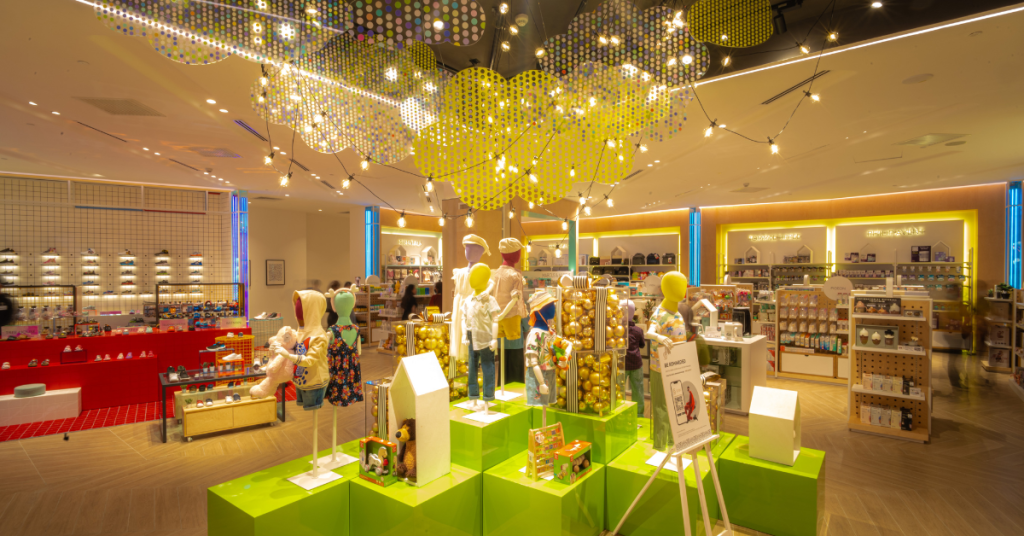
“We are not just retailing products, but we hope to create a platform for you to socialise with family and friends. And most importantly, to create unforgettable moments and memories at SEIBU,” said Yutani.
Guided by its tagline, “What’s new? Be Surprised”, SEIBU aims to serve as a place of inspiration to shoppers. To achieve this, the Japanese brand is dedicated to curating great merchandise and brand experiences, featuring a distinctive fusion of Japanese craftsmanship and “omotenashi”.
Also Read: Earn RM2.4k/mo as an intern in the capital markets via the investED leadership programme
Featured Image Credit: SEIBU
Last year, we predicted these 2023 industry trends. Here’s what we actually got right.

At the end of 2022, we sat down to come up with some industry and business trends we foresaw would happen in 2023. Now that we’re nearing the end of the year, it’s time yet again to look at these predictions to see whether we had hit the nail on the head.
1. Deep learning and AI tech will be used to complement creative industries: Came true!

Having attended quite a number of business talks, I know firsthand that “AI” has been an absolute buzz word this year.
Specifically, when it comes to the creative industry in specific, generative AI technology seems to have taken centre stage. There have been so many AI tools from ChatGPT and Midjourney to more obscure ones that can help businesses generate creative marketing assets.
New creative AI tools that appeared on the market this year include Adobe Photoshop’s generative AI tool that has also often gone viral on social media. These advancements have certainly made an impact on the global creative ecosystem, which most definitely would trickle into Malaysia too.

For one, homegrown burger chain myBurgerLab had used Midjourney to come up with an illustrated graphic. Unfortunately, many netizens seemed to have disliked the notion of using AI-generated imagery.
Although it had generated some backlash, it arguably did its job by generating conversations and getting some eyeballs on the business. Still, it may be a sign that not all Malaysians are on board with the AI train.
That aside, another local entity Fly FM also launched its very own an AI radio DJ by the name of DJ Aina (get it?).
2. Locally-made meat and dairy alternatives will cater to our appetites: Kind of came true?
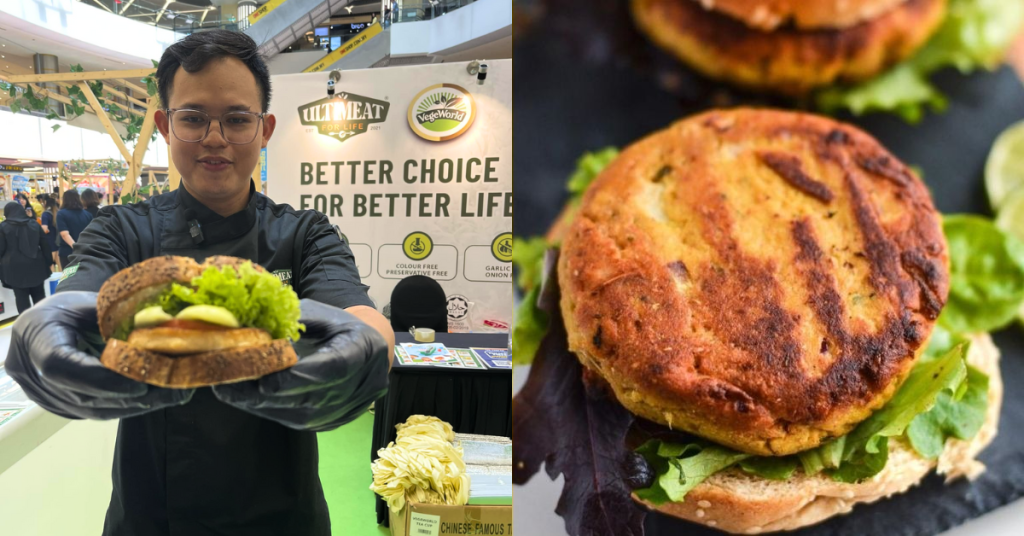
Even before 2023, there have already been a number of prominent alternative meat brands in the industry. For example, there’s Ultimeat, Nanka, Ento, and more. Same goes when it comes to vegan milks, with options like Snappea in the market.
This year, though, it seems like these offerings have become more refined and the industry has welcomed a few new names with great potential.
Some that Vulcan Post has covered include Meamo Foods, a homegrown brand selling meatless and fishless canned tuna and meat. There’s also In The Pink Co., which sells plant milk concentrates, a more affordable plant-based milk option.
We uncovered both of these brands at events we attended such as VEG FEST 3.0 and Food & Drinks Malaysia. On that note, it does look like there have been more vegan and vegetarian events this year.
Aside from these new homegrown brands, Singapore’s MAD Foods also launched its plant-based and dairy-free coffee in Malaysia back in September. The founders had told Vulcan Post that they believed Malaysians have become more accepting of plant-based alternatives.

A local brand by the name of WonderMeat has also recently launched, offering a dry mix plant-based meat primarily composed of soy and pea protein.
Perhaps something that is gaining relevance, though, is not just plant-based meat but also lab-grown meat, which is also an alternative option.
Cell Agritech is a Malaysian startup we highlighted this year that’s been pushing the envelope on this front. Its RM20 million factory in Penang is currently in the works, and we can’t wait to see their products hit the market.
3. Electric car and bike ownership will be accelerated: Came true!

It was reported that the number of registered EVs increased to over 3,400 units in 2022 and exceeded 7,500 units by September 2023.
And if you’re even remotely interested in EVs, you’d know that Malaysia has recently seen a huge advancement in this area with the arrival of Tesla.
In the tabling of Budget 2024, there were new allocations and the continuation of tax relief incentives in the EV realm, so hopefully, this will be an industry that continues to grow in the coming year.
4. Esports and gaming will be taken to the next level through other industries: Not really?
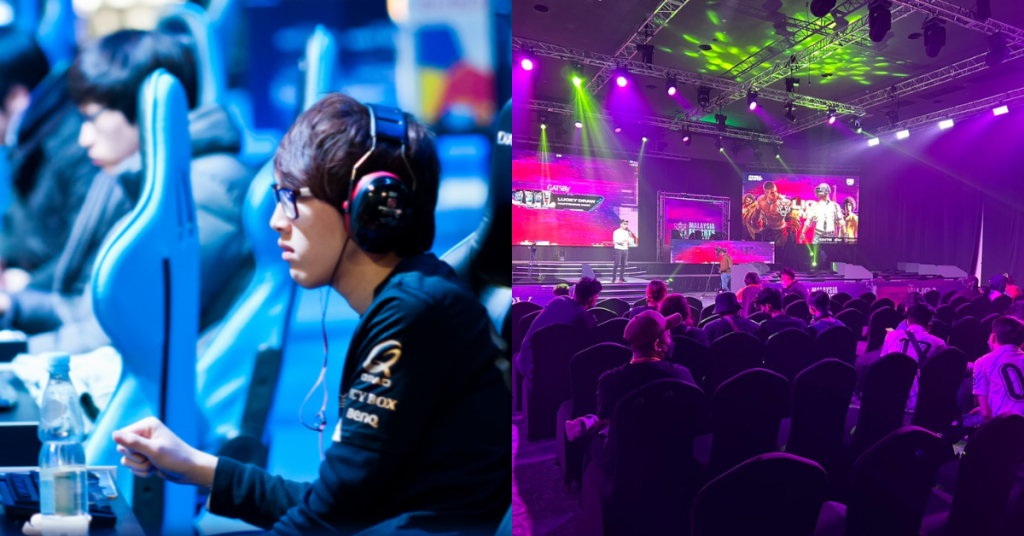
Esports in Malaysia has continued to grow over the years, that much is true. This growth is something that the government has been supporting, too.
During the tabling of Budget 2024 in October, Minister Anwar Ibrahim said that the government is setting aside RM30 million to promote Malaysia as a development hub for esports, encouraging international video games companies to invest in the country.
Meanwhile, support for local studios is present too. For example, institutions such as MDEC and Matrade had supported Malaysian gaming studios, bringing them to the Tokyo Game Show 2023. MDEC’s LEVEL UP KL event also helped showcase and spotlight local games.
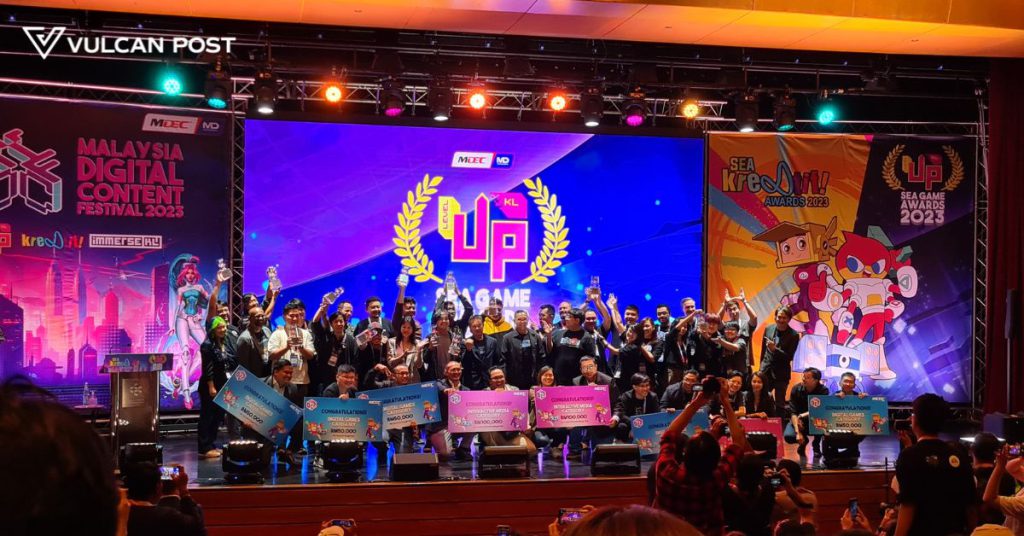
However, the hope of the industry being taken to the “next level” arguably hasn’t come true.
Looking up “esports hub” and “Malaysia”, you’ll see many headlines about grand plans to make Malaysia an esports hub.
To be honest, over the years, we’ve seen this sentiment being repeated, but when will that bright future that Malaysia has in this sector actually become our present? Will 2024 finally be the year we see the industry grow by leaps and bounds? We can only wait and check back in next year.
5. The gig economy sector will see increased efforts to grow its sustainability: Not as much as we’d like to see

Earlier in the year, it was announced that informal jobs (such as gig workers) in Malaysia have increased by 7.7% in the first five months of 2023. However, have efforts to protect the sustainability of gig workers also increased?
Indeed, there have been some steps taken by companies like Grab over the year, such as the recent continuation of its partnership with PERKESO whereby the company is subsidising self-contributions made by its Ultimate partners (Grab’s top performing driver- and delivery-partners).
However, there haven’t been as many advancements as we’d like to see. For one, there hasn’t been updates on the Gig Economy Commission Malaysian (SEGiM).
This commission was something that our Deputy Prime Minister Datuk Seri Ahmad Zahid Hamidi reportedly said in July would be established as soon as possible to improve social protection and the welfare of workers in the industry.
That said, Budget 2024 has seen some allocations for the gig work economy.
RM35 million went into the Career Building Programme through SOCSO which helps ensure informal workers, especially those in the gig economy, can develop their careers and access micro credential skills training programmes.
The government’s share of contribution under the Self-Employment Social Security Scheme (SKSPS) will also be increased to 90% with an allocation of RM100 million. The prime minister also urged gig economy companies to cover the remaining 10% of the contribution on behalf of gig workers.
Another win for the industry is that some familiar yet lesser-known startups in the gig economy have gotten funding this year. There’s Kiddocare and Qwork, both being platforms we’ve featured in the past.
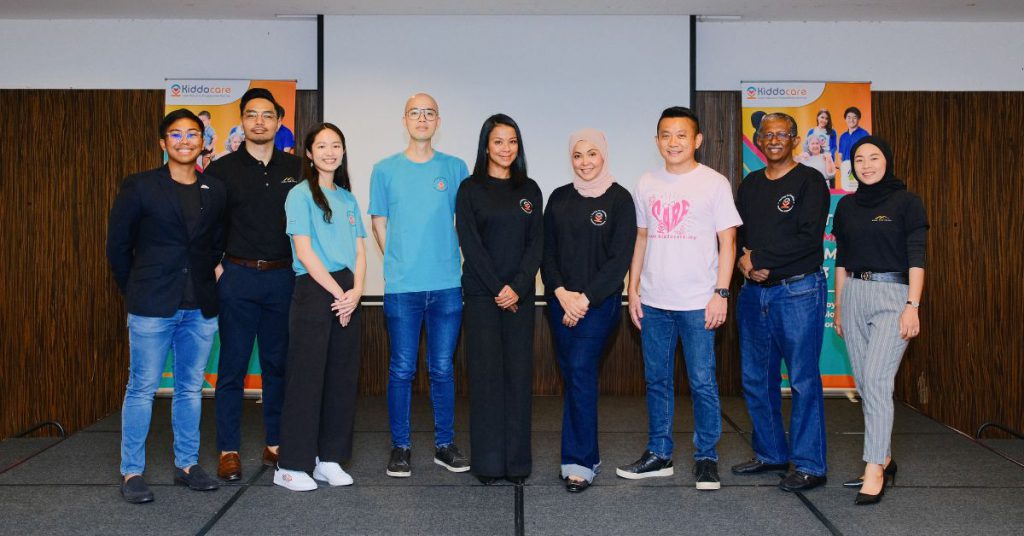
Caregiving platform Kiddocare had closed a seven-figure pre-Series A round in September.
Meanwhile, Qwork announced mid-November that it’s in the midst of its series A and closed an investment from Artem Ventures. Qwork is a hiring platform that provides relevant skill training to gig workers and matches them to companies. One of its aims is to create more sustainable benefits for all giggers.
While we’re happy to see these startups scale up, we hope so see more options and solutions for the gig economy especially from the bigger players in the coming year.
6. Social commerce will become a preferred alternative to regular online shopping: Came true!

Success for social commerce comes most prominently in the form of TikTok Shop. The platform has become such a powerhouse in the Malaysian ecommerce scene this year. Although it launched April last year, it’s really picked up momentum this year.
TikTok Shop Malaysia told Vulcan Post that it saw a 78% increase in SME sellers onboarded between January to June 2023.
However, in October, TikTok Shop shut down in Indonesia to comply with the country’s decision to essentially ban social commerce (AKA ecommerce transactions on social media platforms).
So, will this sentiment also enter Malaysia? It was announced early November that the communications ministry would be looking into TikTok Shop regulations, so perhaps 2024 might see some changes in the social commerce sector.
7. Agritech will see a renewed appreciation and newer, younger entrants: Not true, but still good!
While we haven’t necessarily seen a lot of new entrants in the agritech scene, it seems like startups in the field have been growing and expanding this year.
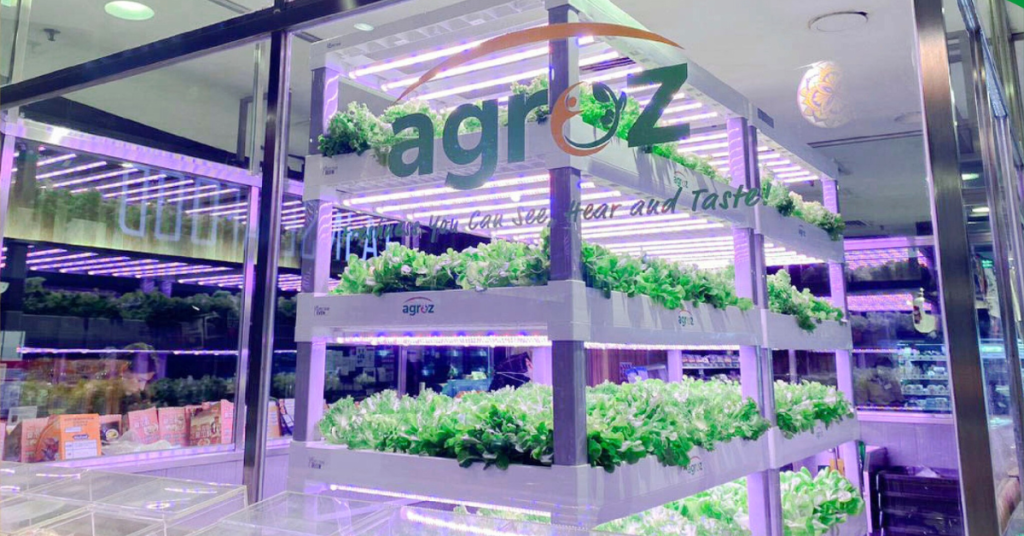
During our visit to Food & Drink Malaysia, we got to catch up with many agritech startups we’ve spoken to in the past and learn about how much they’ve grown. It appears that startups like Kairos Agriculture, a smart vanilla farm, has been able to sustain itself and expand into agritourism.
Another business that we had kept our eye on, Fresh Growcer, has expanded into Utama Farm, another agritour-based business. Seems like educational and experiential activities have been all the rage in 2023.
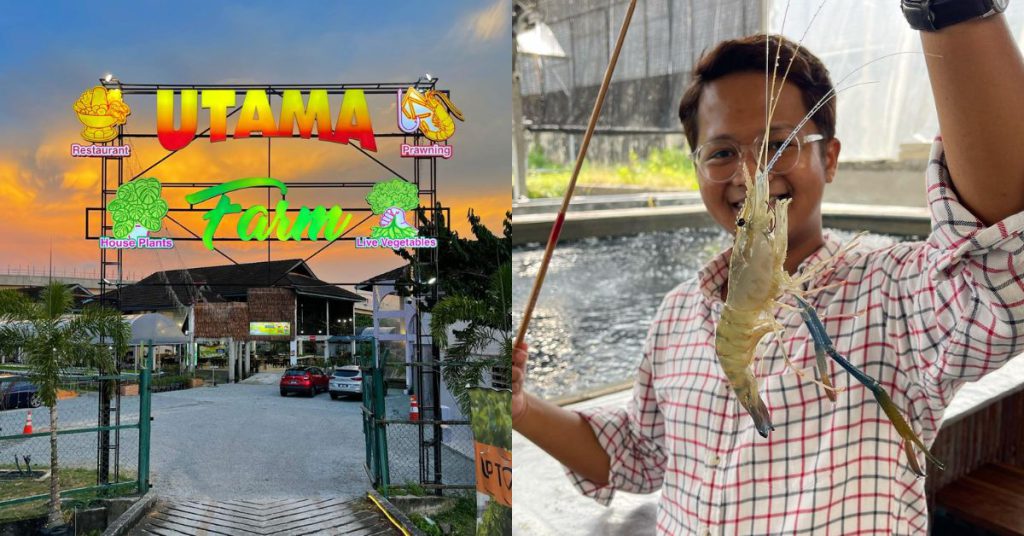
We also got in touch with companies like Agroz Group, which has partnered with AEON to open vertical farms in its malls. Aside from scaling massively via this partnership, the agritech company also has bold ambitions to go public on NASDAQ next year.
So, while we haven’t seen many new startups, it’s great to know that many businesses in the scene are scaling up.
The search for the next unicorn remains elusive, but is it really that important?
Last year, we had wondered whether a new unicorn startup would grace the Malaysian scene, but that hasn’t come true, at the time of writing, anyway.
However, how much of a marker of success is a unicorn anyway?
Instead of a highly valued company, perhaps high-growth or sustainable companies are much more attractive nowadays, as explored in our article that looks into “zebra” and “camel” startups as opposed to just unicorns.
With 2024 just around the corner, looks like it’s also time to pen down our predictions for the next year, so stay tuned for our forecast for trends for the coming year.
- Read other articles we’ve written about Malaysian startups here.
Also Read: SEBA created its own AI assistant to innovate its awards ceremony, here’s how it works
Featured Image Credit: Tesla Malaysia / DJ Aina / Utama Farm

